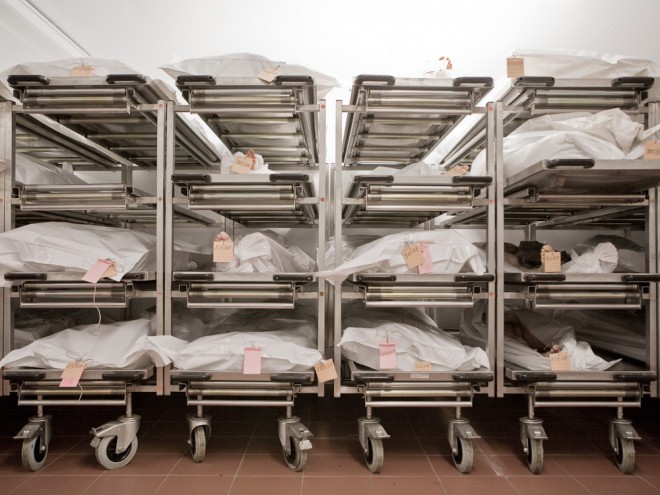NSFW: When Dead Bodies Are Your Job, Death Becomes a Way of Life
Article originally appeared on Wired
If you’ve ever watched a crime scene drama like CSI, you’ve probably asked yourself, “Is that what really happens?” German photographer Patrik Budenz wondered the same thing, but unlike most of us, he decided to put in the time to find out.
To sate his curiosity, Budenz spent months convincing the Institute of Legal Medicine and Forensic Sciences in Berlin to give him full access to their facilities. For years after, he was constantly around cadavers. The results are two photo series: search for evidence (published as a book in 2011) is about forensic scientists and post mortem (published as a book this year) covers all the places dead bodies visit after death — funeral homes, crematoriums, etc.
“I wanted to confront myself with death and develop my view on the topic more fully with post mortem,” says Budenz. “Instead of shooting photos from a distance [like in search for evidence] I reduced the physical and mental distance in post mortem.”
While far from the only photo project on the subject, the tone and balance of Budenz’s projects stand out. They convey a peaceful acceptance of mortality that can be uncomfortable at first and then calming. Part of the discomfort is due to his unwillingness to pull many punches. With full access to these various institutes of death, Budenz was witness to some shocking visuals. He’s made photos of people sawing into heads, photos of people pulling brains out of bodies, photos of people smiling while they work with human body parts, and one particularly horrifying photo of a 13-year-old girl with her chest cut open.
Realizing most people would be taken aback by scenes like this, Budenz says he tries to be as sensitive but also as truthful as he can. The forensic scientists sawing open bodies to conduct investigations while smiling, for example, is a real part of a process most of us prefer not to think about. Dealing with human body parts is a serious job, but just like any job, it becomes routine over time.
“For most of these people, this becomes just a normal workplace,” he says. “Like other people who work in offices, they talk about what happened the day before or what happened that evening, typical chatting. At the same time, they also have a certain sensitivity because of where they are.”
So far, the reaction to the work has been positive. Some people think the photos go too far, and some people have to warm up to them, but he says “curiosity usually takes over.”
In the post mortem boom, the only text he includes is an email from a woman in China who titles her message, “i really like your photos of the dead.” In the message she talks about how hard it was to confront her grandfather’s death, but ends by saying, “i was shaking that night when he passed away, i didn’t even fall to sleep. i couldn‘t sleep alone for three years after he passed away. now i can sleep alone.”
Budenz says he included that email because he thinks it gets right to the point of the photos. Death is hard to deal with, but with time it can become more approachable and a little easier to understand.
WARNING: THE IMAGES in this gallery feature some intense scenes of gore and death. If you’re uncomfortable with such things, now’s your chance to hit the back button.


















All photos: Patrik Budenz



